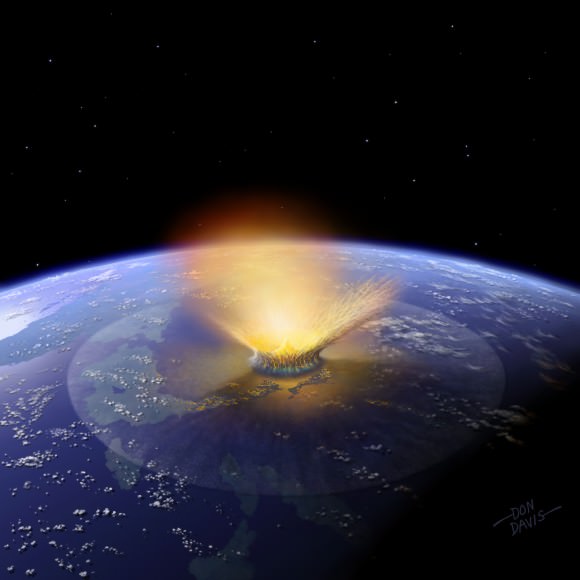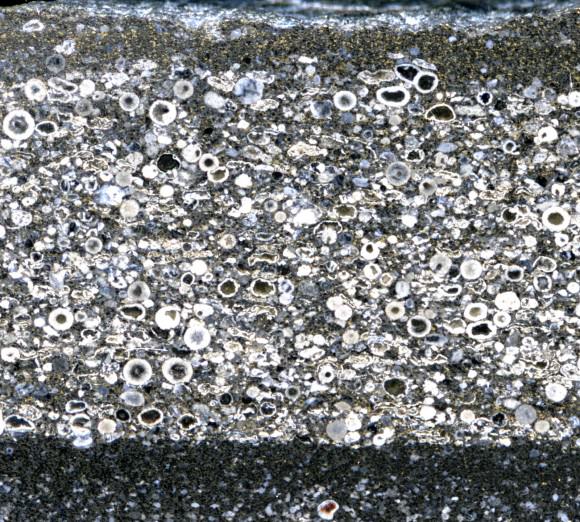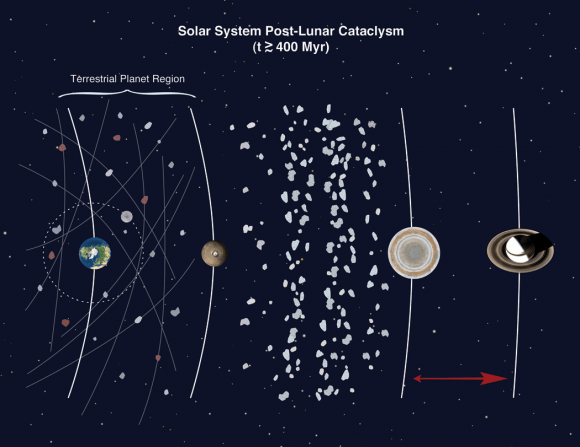
This image shows an artist’s depiction of a 10-kilometer (6-mile) diameter asteroid striking the Earth. Approximately 70 of these dinosaur killer-sized or larger impacts hit the Earth over a span that lasted between 3.8 and 1.8 billion years ago. Credit: Don Davis/Southwest Research Institute.
Even though the Late Heavy Bombardment is somewhat of a controversial idea, new research has revealed this period of impacts to the Earth-Moon system may have lasted much longer than originally estimated and well into the time when early life was forming on Earth. Additionally, this “late-late” period of impacts — 3.8 billion to 2.5 billion years ago — was not for the faint of heart. Various blasts may have rivaled those that produced some of the largest craters on the Moon, and could been larger than the dinosaur-killing impact that created the Chicxulub crater 65 million years ago.
“Our work provides a rationale that the last big impacts hit over an extended time,” said William Bottke principal investigator of the impact study team at the NASA Lunar Science Institute’s Center of Lunar Origin and Evolution (CLOE), based at the Southwest Research Institute (SwRI) in Boulder, Colorado.
The evidence for these prodigious impacts comes from bead-like impact ‘spherules’ found in millimeter- to centimeter-thick rock layers on Earth and date from the Archean period of Earth’s history, more recent than the estimated LHB period of 4.1 to 3.8 billion years ago.
“The beds speak to an intense period of bombardment of Earth,” Bottke said. “Their source long has been a mystery.”

The millimeter-scale circles and more irregular gray particles are formerly molten droplets ejected into space when an asteroid hit the early Earth. The image at left is from the Monteville layer in South Africa. Courtesy Bruce Simonson, Oberlin College and Conservatory
The circles seen in the image above are all formerly molten droplets ejected into space when an asteroid struck the Earth about 2.56 billion years ago. The droplets returned to Earth and were concentrated at the base of the Reivilo layer in South Africa.
The spherules still contain substantial extraterrestrial material, such as iridium (176 parts per million), which rules out alternative sources for the spherules, such as volcanoes, according to Bruce Simonson, a geologist from the Oberlin College and Conservatory who has studied these ancient layers for decades.
The timing of these impacts also coincides with a record of large lunar craters being created more recently than 3.8-billion years ago.
At least 12 spherule beds deposited between 3.47 and 1.7 billion years ago have been found in protected areas on Earth, such as in shales deposited on the seafloor below the reach of waves.
From these beds, the team found evidence of approximately 70 impacts on Earth during this time period that were likely larger than the Chicxulub impact.
In their paper, which was published in Nature, the team created a computer model of the ancient main asteroid belt and tracked what would have happened when the orbits of the giant planets changed. They extended the work of the Nice Model, which supports the theory that Jupiter, Saturn, Uranus and Neptune formed in different orbits nearly 4.5 billion years ago and migrated to their current orbits about 4 billion years ago, triggering a solar system-wide bombardment of comets and asteroids called known as the LHB.

This image shows a representation of how the giant planets have migrated to the current orbits, destabilizing the extension of the primordial asteroid belt closest to Mars. This drove numerous big impactors onto orbits where they could hit the terrestrial planets, though over a long enough time span that this drawn-out barrage may have lasted more than a billion years. The frequency of these impacts on Earth was enough to reproduce the known impact spherule beds. Image Courtesy David Kring, Center for Lunar Science and Exploration, and the Lunar and Planetary Institute
The new computer model shows that the innermost portion of the asteroid belt could have become destabilized, delivering numerous big impacts to Earth and Moon over longer time periods.
Have there been any previous indications about this period of impacts?
“The problem is that we have almost no Archean rocks,” Bottke told Universe Today. “The oldest terrestrial craters, Sudbury and Vredefort, are 1.85 and 2.02 billion years old. The spherule beds are our only window into impacts prior to this time.”
Also, Bottke said, the number of people who look for impact spherules is almost equally scarce. “People such as Bruce Simonson, Don Lowe, Gary Byerly, and Frank Kyte, have been carrying on a long, lonely quest to try to get people to consider the implications of their work, which are deeply profound, in my opinion,” Bottke said.
As for finding evidence of this later period of impacts on the Moon, Bottke said the problem there is the lack of solid ages for most impact events.
“This means it is difficult say anything definitive about the timing of major impacts,” Bottke said. “We are working this problem now with Michelle Kirchoff, who is counting craters on top of large lunar craters. This can be done now that we have LRO data.” (Listen to a podcast interview of Kirchoff on the 365 Days of Astronomy.)
Still, Bottke said, without using “fancy dynamics,” they can address some issues.
“Studies in the post-Apollo era suggested that the Moon has four 160-300 km craters that formed after Orientale, whose age is 3.7-3.8 billion years ago and (i.e., K/T-sized events or larger),” he said. “Crater counts from the Galileo mission and Apollo-era geologic analyses suggest at least one of these events took place near 3.2-3.5 billion years ago. If we account for the gravitational cross section of the planets, we know that for every lunar event, we should get about 20 on the Earth. So, from this argument alone, one should get a lot of big impacts on the Earth after the formation of Orientale.”
The new study fits with the available constraints about impacts on the Moon as well as finding the right distribution of spherule beds on Earth.
The best way to confirm everything, however, Bottke said, would be if more lunar rocks from various locations were available for study.
Further reading:
Press release from SwRI.
NLSI press release
Press release from SwRI.
NLSI press release
Source: Universe Today
No hay comentarios:
Publicar un comentario